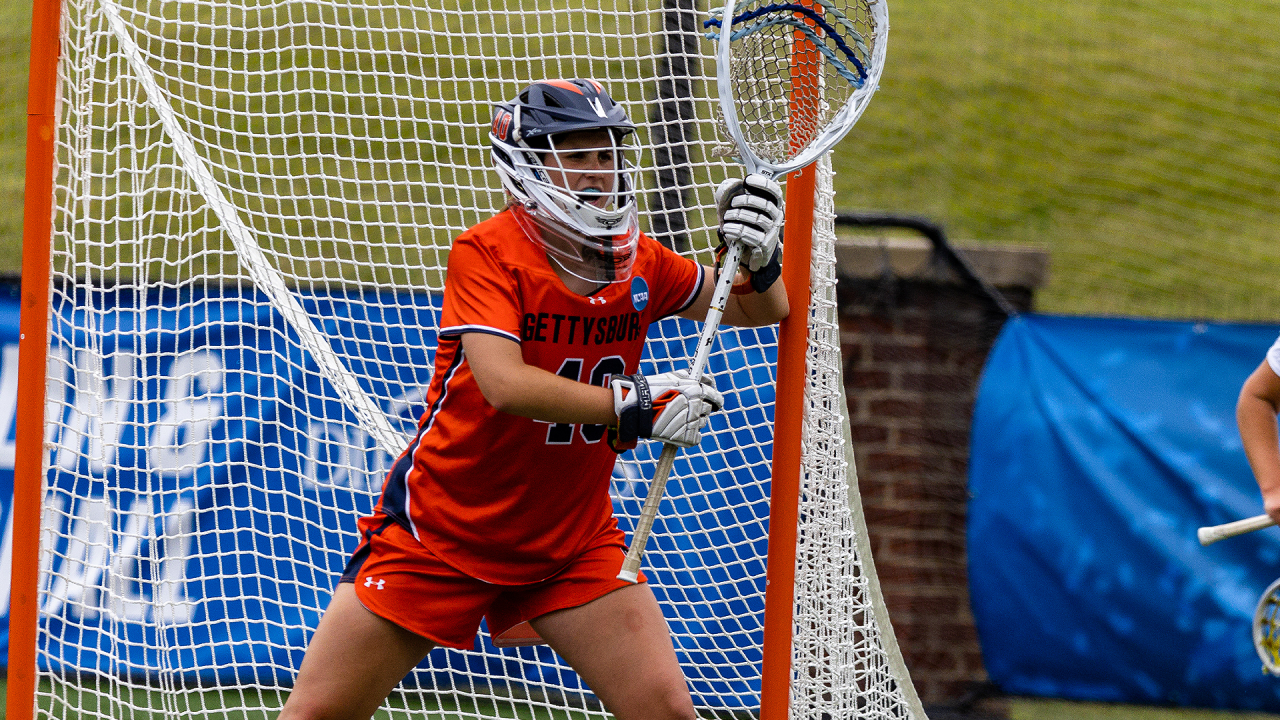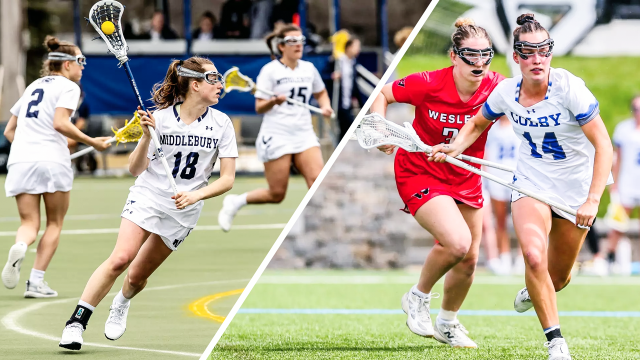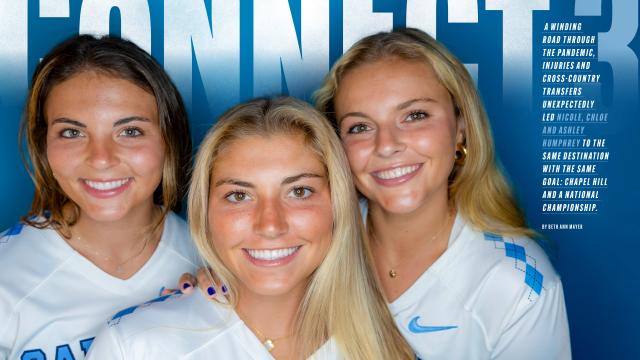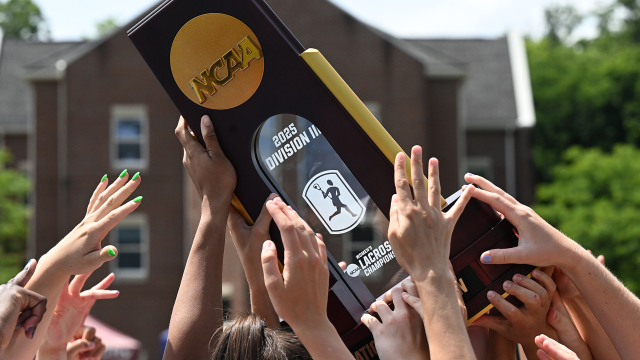
Beyond the Basics: Advanced Metrics That Define Every D-III Women's Top 20 Team
Advanced metrics are common in other major sports, and Lacrosse Reference is helping to make them mainstream in lacrosse.
Lacrosse Reference goes beyond the box score. Beyond the basics, if you will. Lacrosse Reference was created in 2016 with the goal of bringing the analytical methods used in other sports to college lacrosse. The site’s focus has been on finding innovative ways to compare teams and players that are more nuanced than the broad-brush metrics that were common at the time.
Analytics expert and Lacrosse Reference founder Zack Capozzi is back ahead of the Division III women’s season to provide insights on one advanced metric per Top 20 team.
For a glossary of terms, head here.
1. MIDDLEBURY
Middlebury’s defense didn’t just dominate; it did so against top-tier competition. The Panthers’ opponent-adjusted defensive efficiency ranked 5th nationally, while their opponent-adjusted shot-on-goal rate and shooting efficiency both hit the top percentile. But perhaps their most exceptional skill was simply preventing shots. They ranked 2nd nationally in shots allowed per possession with an opponent-adjusted rate of just 0.39. Think about that: for every five possessions the defense faced, it allowed just two shots.
2. GETTYSBURG
A clear indicator of success for Gettysburg was its assist-to-turnover ratio, with the team boasting a 12-0 record when the ratio exceeded 0.58 and an 0-4 record when it did not. The Bullets scored on 44% of their offensive possessions when their assist-to-turnover ratio was above that mark, versus just 26% in the games when it fell below. No guarantee that this pattern will persist, but last year at least, the key to stopping Gettysburg was not letting its passes find open teammates.
3. WILLIAM SMITH
William Smith boasts an impressive offensive lineup, retaining 84% of its offensive production from a year ago. With a national ranking in the 99th percentile for opponent-adjusted efficiency, the team’s offensive unit, led by stars like Maddie Montgomery and Natalie Daniels, looks poised to continue their dominance. The big question is whether the integration of new talent, including transfer Alex Tapia, adds to the mix or whether there are some initial growing pains.
4. WASHINGTON AND LEE
Washington and Lee’s offense and draw control unit remain largely intact, retaining 78% and 96% of production, respectively. This continuity, highlighted by Eugenie Rovegno’s draw control wins that placed the team in the 99th percentile nationally, suggests that the Generals will continue to dominate possession and maintain offensive pressure. But the loss of Allie Schwab, who recorded 22% of the team’s assists, will test the Herons’ ability to create scoring opportunities, making it essential for returning players to step up.
5. TUFTS
Margie Carden’s role saw a significant uptick last year, with her assist share nearly doubling from 8.2% to 16.5% and her usage rate climbing from 8.9% to 12.7% between 2022 and 2023. Despite the increased responsibility and defensive attention, her ball security remained stellar at the 97th percentile, and her individual efficiency, while slightly lower than the year before, was still an impressive 82nd percentile. Carden’s resilience and adaptability in the face of increased defensive attention made her a star last year. With that sort of statistical profile, the sky is the limit in 2024.
6. FRANKLIN & MARSHALL
The most important metric for F&M last year was shooting percentage. When F&M shot above 37.5%, its record was an impressive 11-1, with a scoring efficiency of 41% on offensive possessions. However, once shooting percentage fell below this threshold, F&M’s record dropped to 1-3, and offensive efficiency plummeted. There was no bigger key to victory for this team than creating quality chances and having shooters put them away.
7. TCNJ
A lot of the success (or lack thereof) that TCNJ experienced in 2023 came down to one facet of the game: whether or not opponents were able to move the ball successfully. TCNJ lost all four games in which the opposing offense had an assist-to-turnover ratio greater than 0.62 (roughly six assists for every 10 turnovers). TCNJ was 8-0 when that ratio was less than 0.62. If you were a patient offense that could take advantage of TCNJ’s pressure to find open teammates, you were very likely to have success. If you couldn’t, you didn’t. It’s that simple.
8. SALISBURY
With the departure of Emma Skoglund, Salisbury is tasked with filling a significant gap in offensive creation. Skoglund was responsible for a full 20% of the team’s assists a year ago. Keep an eye on Maggie Sanders potentially emerging as a candidate to take on this challenge. She played a relatively small role last year, with 7% of the team’s assists, but she did it incredibly efficiently, with a 95th-percentile individual efficiency rating. If Sanders can scale up her playmaking abilities, she could be pivotal in maintaining Salisbury’s impressive 91st-percentile opponent-adjusted efficiency rating.
9. YORK
Zoe Kluegel stepped up for York in 2023, taking on a larger offensive role with her shot share jumping to 15.2% and finishing with a shooting efficiency in the 79th percentile. Her ability to score without relying heavily on assists, with over half of her goals unassisted, is particularly noteworthy. However, during periods when her assist rate dipped, so did her overall efficiency, suggesting that balancing her scoring with facilitating could be an area for future development.
10. COLBY
Colby faces a schedule that is a blend of challenge and opportunity. With a non-conference strength-of-schedule ranked 29th, down from last year’s 10th, Colby has the chance to build confidence with some early wins. Dropping Salisbury and Chicago does mean they’ll be less battle-tested heading into the gauntlet of conference play. All in all, though, the overall schedule remains tough, projected to be 9th in difficulty, so it’s not as if they are playing a bunch of cupcakes.
11. WESLEYAN
Wesleyan’s 2023 defensive unit was nothing short of impressive, finishing the year as the 4th-ranked opponent-adjusted defense. The most impressive individual facet of the defense was its ability to make opposing offenses uncomfortable. The defense allowed a 72% shot-on-goal rate, which, after adjusting for the strength of opponents, was the second-best mark in the nation.
12. MESSIAH
Facing a non-conference slate that projects as the 6th-toughest in the country, up from 12th a season ago, it could be tough sledding for Messiah. It’s a calculated risk by the coaching staff that aims to forge a team that’s battle-ready for the postseason. Still, the LaxElo model projections anticipate a solid season with an expected average of 12.8 wins against 4.2 losses. Even with the difficulty leveled up, there should still be plenty to celebrate. And with luck, the risk will pay off in the form of a deep run in May.
13. ST. JOHN FISHER
Control of the draw circle has been a significant factor in St. John Fisher’s ability to dictate the pace. And with the team returning an impressive 92% of its draw control experience, including Sydney Carpenter’s 182 draw controls, I’d expect that to continue. Carpenter was their highest-usage player last year on the offensive side as well, and I’m sure she’ll be attracting most of the defensive focus again.
14. POMONA-PITZER
The departure of Maggie Sweeney from Pomona-Pitzer’s draw unit is a challenge, with just 45% of draw experience returning. Hannah Gough and Taylor Glanville have both shown promise and should be the primary draw contributors this year. But with an offense that is returning 70% of its production and a defense returning 89% of its games played, the Sage Hens are in good shape overall.
15. TRINITY
Trinity’s schedule is projected to be the 6th toughest nationally. More specifically, its non-conference schedule difficulty is projected to jump from 39th to 21st. With a projected record around 9-6, Trinity’s performance against this arduous lineup will be pivotal in surpassing last year's 13th-place RPI finish and continuing an ascent in Division III lacrosse.
16. ROANOKE
Roanoke’s schedule looks like a strategic shift towards tougher non-conference games, aiming to test the team’s mettle early. With a non-conference strength-of-schedule projected as 6th toughest, up from 40th the previous year, the team faces the challenge of balancing the benefits of rigorous competition against the risk of dampening morale with potential losses. The outcome of this ambitious scheduling will be crucial in determining whether Roanoke can build upon last season’s successes or face setbacks due to the increased competition.
17. CHICAGO
The departure of Katie Large has left a ... large ... gap in Chicago’s draw control game, an area it excelled last season, ranking in the 90th percentile for opponent-adjusted draw-control win rate. With just 69% of draw control production returning, the onus is on players like Jill Hooey and Lizzie Huesman to uphold the high standard. How effectively Chicago adapts to this change in personnel could have a substantial influence on its ability to control the flow this spring.
18. DENISON
Denison’s offense is grappling with the loss of key players, retaining only 64% of last season’s offensive production. The loss of Allaire Kotz, Jane Bailey and Emma Repke stings. The team will look to Josie Lucchesi, who had an individual efficiency rating of 69 (out of 100), to be a bigger part of the offense and help shepherd younger players into larger roles. Considering the team finished in the 76th percentile for offensive efficiency last season, it’s an open question whether it can maintain this strength.
19. STEVENS
The Stevens defense was clearly impacted by the number of offensive possessions it faced. When opponents were limited to fewer than 36 offensive possessions in a game, Stevens was 12-0, with the opposition scoring on just 18% of those possessions. However, when the opposing team exceeded 36 offensive possessions, Stevens struggled, with a 2-3 record and a higher per-possession offensive-efficiency of 29% for its opponents.
20. ITHACA
Ithaca enters the new season with an experienced roster, boasting a median of 40 career games played among rotation players, and retaining 98% of its offensive production. The team’s strength on the draw, led by Caroline Wise, and a solid defense returning 99% of its contributions, positions Ithaca for a solid 2024. If players like Wise can improve their individual efficiency, Ithaca’s offense, which finished 2023 in the 80th percentile, could sniff elite status.
Zack Capozzi
Zack Capozzi's career peaked when he scored a goal in a men's league game against a defense that had a guy wearing a Delaware helmet. He (smartly) ended his playing career and now runs LacrosseReference.com where he uses numbers to uncover the hidden stories of college lacrosse.

Categories
Related Articles




